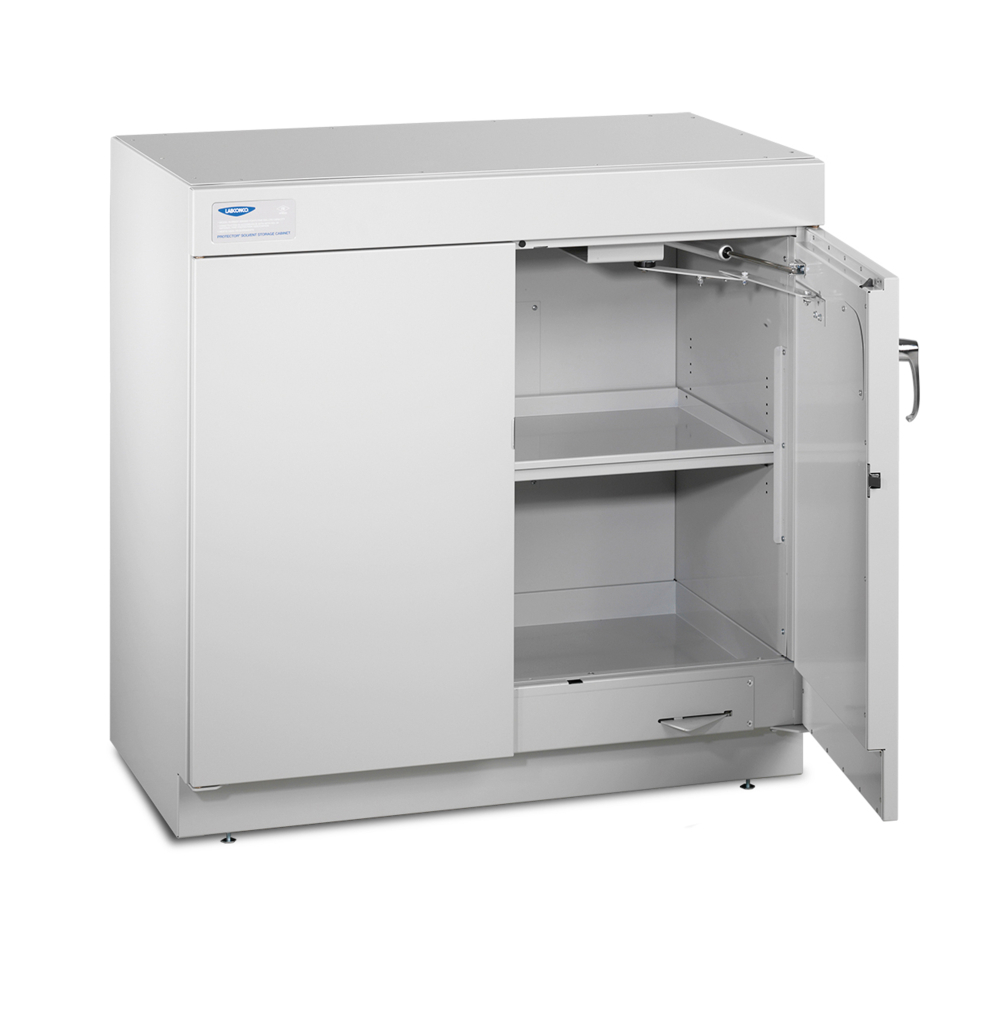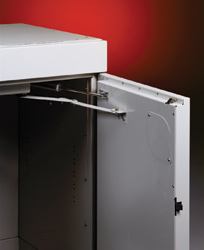The Solvent Storage Cabinet - A Laboratory Super Hero

The purpose of a solvent or flammable cabinet is to protect the flammables inside in the event that the laboratory is on fire. The accepted standard on cabinet construction is National Fire Protection Association (NFPA) 30, Flammable and Combustible Liquids Code Handbook, with Underwriter’s Laboratory (UL) and Factory Mutual (FM) offering third party evaluation of cabinet construction and performance.
Cabinet Construction
Solvent storage cabinets typically have a double wall; this acts as in insulator from potential exterior heat. They also have a solid steel top, even if a work surface is to be placed over the cabinet. Cabinet doors are also double walled, and should have three point latching systems.
A common feature is self-closing doors with a fusible link. If the self closing doors are latched open, and the laboratory is on fire, the fusible link will allow the doors to close if the temperature reaches 165 F.
Labels and Standards
Additionally, these cabinets usually have a grounding feature to prevent the discharge of static electricity. All cabinets designed to store solvents are easily identified with a bold note in red lettering: FLAMMABLE, KEEP FIRE AWAY.
A Factory Mutual Listing on a solvent cabinet means that it was tested and approved by Factory Mutual to meet Factory Mutual Approval Standard 6050. The introduction of the Standard states that “The requirements of this standard are based on experience, research and testing, and in large part on NFPA 30.”
Carrying the FM listing also means the manufacturer has agreed to facility audits. Ongoing product audits are part of the Approved Product Follow-Up Program, and are required to maintain the FM Listing.
The Underwriters Laboratory 1275 label for cabinets and FM listings are largely the same, and both are based on NFPA 30. NFPA 30 Chapter 4.3.3 (a) states, “Storage Cabinets shall be designed and constructed to limit the internal temperature at the center, 1 inch (2.5 cm) from the top, to not more than 325 degrees F (162.8 degrees C) when subjected to a 10-minute fire test with burners simulating a room fire exposure using the standard time temperature curve as given in NFPA 251, Standard Methods of Fire Tests of Building Construction and Materials. All joints and seams shall remain tight and the door shall remain securely closed during the fire test.” This is the core of both UL and FM solvent cabinet evaluations, and the reason for the robust construction of solvent cabinets.
Solvent Cabinets
Ignitible* (Flammable or Combustible) Liquid Storage Cabinets
The purpose of a solvent or flammable cabinet is to protect the ignitible (flammable or combustible) liquid contents stored inside the cabinet during a laboratory fire. The accepted standard on cabinet construction is National Fire Protection Association (NFPA) 30, Flammable and Combustible Liquids Code Handbook, with Underwriter’s Laboratory (UL) and Factory Mutual (FM) offering third party evaluation of cabinet construction and performance.
Cabinet Construction
Solvent cabinets have a double wall; this acts as in insulator from potential exterior heat. They also have a solid steel top, even if a work surface is to be placed over the cabinet. Cabinet doors are also double walled, and should have a three-point latching system. A common feature is self-closing doors with a fusible link.
If the self-closing doors are latched open, and the laboratory is on fire, the fusible link will allow the doors to automatically close if the temperature reaches 165 degrees F. The bottom of a solvent storage cabinet is liquid tight to a height of not less than two inches. Additionally, these cabinets have a grounding feature to prevent the discharge of static electricity. All cabinets designed to store ignitible (flammable or combustible) liquids are easily identified with a bold note in red lettering: FLAMMABLE, KEEP FIRE AWAY.
Cabinet Listings
A Factory Mutual Listing (FM) on a solvent cabinet means that it was tested and approved by Factory Mutual to meet Factory Mutual Approval Standard 6050. The introduction of the standard states that "the requirements of this standard are based on experience, research and testing, and in large part on NFPA 30." Carrying the FM listing also means the manufacturer has agreed to facility audits. Ongoing product audits are part of the Approved Product Follow-Up Program, and are required to maintain the FM Listing.
Underwriters Laboratory Standard 1275 (UL 1275) Flammable Liquid Storage Cabinets scope indicates that “the cabinets covered by these requirements are intended for installation in accordance with the National Fire Protection Association Flammable and Combustible Liquids Code, NFPA 30.”
The UL 1275 label for cabinets and FM listings are largely the same, and both are based on NFPA 30. NFPA 30 9.5.3 (1) details performance requirements as "Storage Cabinets designed and constructed to limit the internal temperature at the center of the cabinet and 1 inch (25 mm) from the top of the cabinet to not more than 325 degrees F (163 degrees C), when subjected to a 10- minute fire test that simulates the fire exposure of the standard time-temperature curve specified in ASTM E119, Standard Test Methods for Fire Tests of Building Construction and Materials, shall be acceptable. All joints and seams shall remain tight and the door shall remain securely closed during the fire test." This is the core of both UL and FM solvent cabinet evaluations, and the reason for the robust construction of solvent cabinets.
Unlisted Cabinets
Though Labconco manufactures a full portfolio of solvent storage cabinets carrying a FM listing, we are often requested to make dimensional variations of these cabinets to accommodate unique project requirements. In circumstances such as these, the resulting cabinet will not carry the FM label, as its unique model number will not be contained in the official listing. However, the cabinet is built to the same exacting standards.
NFPA 30, 9.5.3 (2) deems this acceptable for use in the storage of ignitable (flammable or combustible) liquids, under the following conditions: "(a) The bottom, top, door, and sides of the cabinet shall be at least No. 18 gauge sheet steel and shall be double-walled, with 1 ½ in (38 mm) air space. (b) Joints shall be riveted, welded, or made tight by some equally effective means. (c) The door shall be provided with a three-point latch arrangement, and the door sill shall be raised at least 2 in. (50mm) above the bottom of the cabinet to retain spilled liquid within the cabinet. (d) New Cabinets shall have self-closing doors." Additionally, 9.5.5 indicates that all "Storage cabinets shall include the following marking: FLAMMABLE, KEEP FIRE AWAY."
Ventilation

According to NFPA Code 30, 9.5.4*, "Storage cabinets shall not be required by this code to be ventilated for fire protection purposes." Because solvent storage cabinets are designed to protect the internal contents from a fire outside the cabinet, a vented cabinet could compromise this ability of the cabinet by drawing in heated air.
NFPA 30 clearly dismisses the need to vent storage cabinets in its appendix. Under A.9.5.4 it states: “Venting of storage cabinets has not been demonstrated to be necessary for fire protection purposes. Additionally, venting a cabinet could compromise the ability of the cabinet to adequately protect its contents from involvement in a fire, because cabinets are not generally tested with any venting. Therefore, venting of storage cabinets is not recommended.
However, because of differing priorities, Health and Safety people often recommend that solvent storage cabinets are kept under negative pressure. The goal being to prevent unneeded exposure to solvent vapor each time the cabinet is opened. Additionally, solvent vent kits are still required by code in certain places. NFPA 30 Section 9.5.4.2 states that "If a storage cabinet is ventilated for any reason, the vent openings shall be ducted directly to a safe location outdoors or to a treatment device designed to control volatile organic compounds (VOCs) and ignitible vapors in such a manner that will not compromise the specified performance of the cabinet and in a manner that is acceptable to the authority having jurisdiction."
If local codes, building safety officer, architect, or lab planner requires the use of a solvent vent kit, solvent cabinet manufacturers typically have kits available. These kits should be made of fire proof materials. They attach to the back of the solvent cabinet, and should be routed to an appropriate dedicated ventilation source. At the point of connection to the cabinet, the manufacturer should provide a flame (or spark) arrestor.
The flame arrestor, which occupies the vent hole, will prevent any potential fire from reaching the interior of the cabinet through the vent pipe. By forcing a flame front through channels too narrow to permit the continuance of flame, a flame arrestor is designed to extinguish a flame and stop fuel combustion. NFPA 30 Section 9.5.4.1 notes that "If a storage cabinet is not ventilated, the vent openings shall be sealed with the bungs supplied with the cabinet or with bungs specified by the cabinet manufacturer."
* There is a level of acceptance for both spellings of ignitable (or ignitible), from a descriptivist perspective. As of this writing, we anticipate a possible nuance of meaning to develop for the less common form (ignitible) used in the context of the NFPA discussion. Therefore, although the form of the word using the vowel a is more common, we use the NFPA’s version for clarity of meaning.
| chevron_left | How Much Faster Can I Freeze Dry by Adding Heat? | Articles | Energy efficiency explained: Potential savings of real labs | chevron_right |






